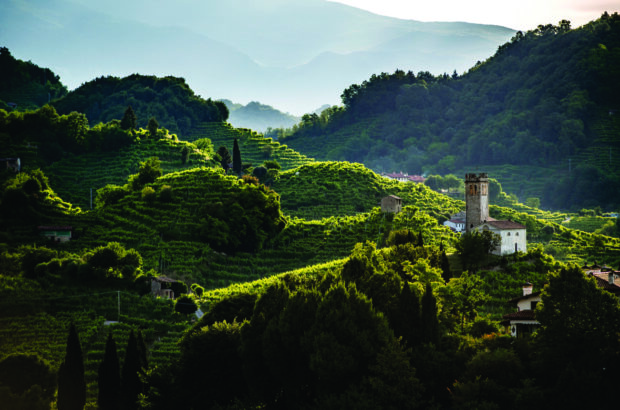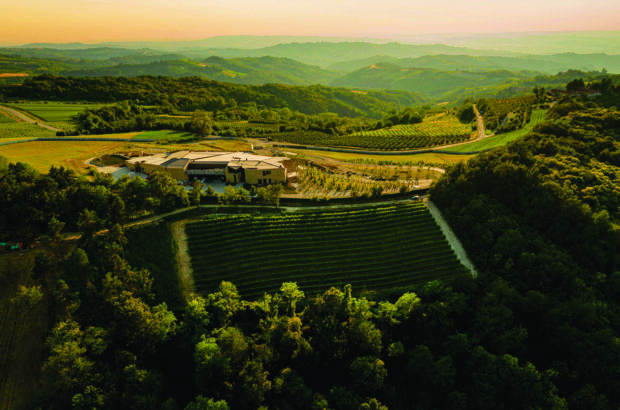Call it absurd. Dub it naive. Describe it, hyperbolically, as the most asinine, most fruitless curb on alcohol ever conceived. We are, of course, speaking of the 18th Amendment of the United States Constitution, which, exactly a century ago, gave the American federal government the means to severely impede the sale of ‘intoxicating liquors’. Ratified, theoretically, to foster a better society, Prohibition proved to have the opposite effect. The forbiddance of alcohol ushered in an iconic era of bootleggers, speakeasies and a wholesale disregard for an amendment that engendered far more problems than its supporters had so naively believed it would resolve.
Ironically, however, all signs would indicate that wine had never been a prime target of prohibitionists, whose sights were set mainly on spirits, an aspect wine-grower Andrea Sbarboro had pointed out as early as 1907. In one of his pamphlets he wrote: ‘No nation is drunken where wine is cheap; and none sober, where the dearness of wine substitutes ardent spirits as the common beverage. It is, in truth, the only antidote to the bane of whiskey.’ But what did this matter? Wine was lumped in, its de facto ban causing untold damage to wine-growing throughout the nation – most devastatingly in California, then as now the most prestigious, most widely planted state in the union.
Prohibition timeline
Late 19th to early 20th century The ‘dry’ movement intensifies in the US; California wine is thriving
1907 Wine-grower Andrea Sbarboro argues that wine is not whiskey
16 January 1919 The 18th Amendment is ratified; sales of ‘intoxicating liquors’ are prohibited
16 January 1920 The Volstead Act takes effect; home winemaking and bootlegging surge
1923 Georges de Latour, owner of Beaulieu Vineyard, plants new vineyards for the booming sacramental wine business
1927 Grape sales for home winemaking reach fever pitch; bootlegging is now rampant
5 December 1933 The 21st Amendment takes effect; Prohibition is repealed
Post-Prohibition Recovery of California wine industry slowly begins; draconian rules are no help
1966 Legendary wine-grower Robert Mondavi founds eponymous winery
24 May 1976 Judgement of Paris wine tasting confirms the quality of California wine

Beaulieu Vineyard in Napa survived Prohibition by making sacramental wine
Cruel blow
On the eve of Prohibition, the California wine industry had been thriving for several generations, the finest wines produced exclusively from Vitis vinifera grapes sourced from familiar regions such as Sonoma or Napa (the former at this time was far better known than the latter) and some other districts. By 1919, about 121,400ha were under cultivation, with more than 700 wineries in operation, all worth, San Francisco Judge DD Bowman asserts, ‘annual revenue[s] of $30,000,000’ for state coffers. ‘In 1919,’ remarks Prohibition authority Vivienne Sosnowski, ‘during an especially glorious autumn before Prohibition, the world was still full of promise for all the wine and ranching families of the valleys. But that promise, along with their faith in their country, would soon be brutally broken.’
On 16 January 1920, the National Prohibition Act came into effect. Better known as the Volstead Act after arch-prohibitionist Andrew Volstead, the effects of Prohibition were all but instantaneous. For example, what to do with some 643,520hl of ready-to-go California wine that, especially after a bountiful 1919 harvest, could no longer be sold? More importantly, how were wineries and the many thousands of families whose livelihoods depended on them going to survive? Could Prohibition be combated by regulatory loopholes? By selling wines illegally?

Congressman Andrew Volstead
According to American wine historian Thomas Pinney, ‘the simplest and most common response to Prohibition on the part of American wineries was to simply go out of business rather than try to stay alive by undertaking new enterprises’, such as making dried table grapes or switching to unfermented grape juice production. Indeed, the challenges seemed insurmountable, from impromptu government agent visits that might, and occasionally did, end with being shut down, to preposterous regulations that permitted the production of wine but not its sale.

Grapes for making sacramental and medicinal wines are loaded into open railroad cars in the vineyards of Guasti, California. Credit: Philip Brigandi, Library of Congress
Survival techniques
Yet some wineries in California did manage to survive, often ingeniously. Legal loopholes were crucial, the most effective being the permittance of home winemaking. ‘In the first vintage of the Prohibition era, 1920, more than 26,000 railroad cars of fresh grapes rolled out of California,’ Pinney reports, with many of them bound for the East Coast for crafting into wine in American kitchens, basements and garages. By 1927, the number of carloads exceeded 72,000, with vine plantings in California nearly double pre-Prohibition levels.
Unfortunately, Pinney notes that the grapes were mostly of deplorable quality: ‘The great explosion of grape planting that took place under Prohibition was not of grapes suited to making good wine but of grapes fit to be transported long distances and capable of attracting an uninstructed buyer – “shipping grapes” rather than true wine grapes.’ Among red ‘shipping grapes’, the most popular, remarks American wine historian Charles Sullivan, ‘were Alicante Bouschet, Zinfandel, Petite Sirah, Carignan and Mataro (Mourvèdre)’. White grape versions were usually far worse.
Other wine-growers turned to religion. At Beaulieu Vineyard (BV) in Rutherford, Napa, for example, winemaker Leon Bonnet crafted wines for the diocese of San Francisco, as the Volstead Act excluded wines meant for ‘sacramental’ purposes. In fact, the religious wine business boomed so well for BV owner Georges de Latour that he took over the lease at Wente Vineyards in Livermore Valley across San Francisco Bay, so that he could sell their fine white wines alongside his own quality reds. We may, nonetheless, only guess as to the percentage of such wines being accompanied by a blessing, to say nothing of wines legally prescribed for medicinal reasons – another Prohibition loophole.
Alternatively, wine-growers merely disregarded the Volstead Act, their wines openly available up and down the coast. In San Francisco, Pinney asserts that restaurants ‘were well supplied by small winemakers in the Bay Area that continued to work despite Prohibition’. He also claims that: ‘Successfully open places were never arrested. The anecdotal literature is pretty big. My impression is that a café or restaurant in wine country, or in a place like North Beach, San Francisco, could serve wine without fear.’ Prohibition agents, moreover, knew exactly what was going on, but largely had the good sense to look the other way – a notion confirmed by wine-grower Everett Crosby, who, Pinney observes, later recalled that at a speakeasy in Pleasanton, Livermore Valley, ‘the mayor and his aides were regularly to be seen through the unshuttered windows… across the street from city hall as they stood at the bar drinking the local red wine’.
Bootlegging, of course, was how wines reached local restaurants and speakeasies. ‘There was a tremendous amount of bootlegging,’ Sullivan claims. ‘In Santa Clara, for example, the local sheriff was probably defeated in an election in an attempt to enforce the law.’
Furthermore, he says: ‘It was not even necessary to bribe. The grapes came from Sonoma and Napa, barged across the bay… At Bargetto [on Monterey Bay], they made limitless amounts of wine. They even had an underground transfer network between the buildings.’ Until the repeal in December 1933, these were the principal ways California wineries could survive and, in some instances, thrive.

A bootlegger’s wreck, 1932
Beyond Prohibition
But by the time of repeal, the overall damage had been done. Compelled by a fed-up public and the dire need for new revenues as the Great Depression intensified, the 21st Amendment might have revoked Prohibition, but it hardly restored California wine-growing to its former status. By the end of 1933, only 380 wineries existed, having risen from 177 at the start of the year in anticipation of repeal. Worse, the entire state, notes Pinney, was nearly devoid of quality grapes. The total hectarage of Cabernet Sauvignon was less than 325ha, with Pinot Noir down to 243ha, 182ha for Riesling and 121ha for Chardonnay. The question now was how to rekindle a once flourishing wine industry from these paltry figures? Would knowledgeable wine-growers ever rediscover the stupendous potential of California’s finest sub-regions, vineyards and sub-sites, and perhaps one day even give their European counterparts something to think about?
Then there was the nature of repeal itself, which largely placed alcohol (including wine) in the direct control of the states. ‘It’s very simple,’ Sullivan crossly describes. ‘The 21st Amendment was a disaster: it solidified states’ rights over wine matters and, via the 10th Amendment, screwed up everything. Just ask a [California] wine-grower today. The restrictions, such as transport through states, are ridiculous. All I’ve heard from wineries is jabbering of the paperwork they have to file to get anything done.’
Today, though rules in California are more relaxed than in many places, the remnants of post-Prohibition regulations remain, their antiquated stipulations stymieing market access across state boundaries and rendering difficult even straightforward initiatives. For example, to welcome visitors at wineries and offer samples, owners must jump through hoops to secure the requisite permits.
Attitudinally, the effects of Prohibition also took decades to efface. Thanks to the huge reputational damage caused by home winemaking, the decades following repeal cast a pall over American confidence in local wine quality. Individuals, most famously the indefatigable Robert Mondavi, would gradually set matters to rights from the mid-1960s onwards, but the truth is that the execrable wines produced during Prohibition soured the national palate for a very long time – much like what happened to the reputation of German Riesling following regulation changes in the early 1970s.
Perhaps the most injurious effect of Prohibition was that it helped convince generations of Americans that wine as a lifestyle choice to be judiciously incorporated at mealtimes, for example, was somehow improper. And while great strides have been made to combat this misconception in recent years, the damage had been done and has yet to be fully undone.
Truly then, call it ridiculous. Dub it immature. Describe it, with worthy exaggeration, as the most unintelligent, most futile check on alcohol ever attempted. But never, ever, ever call Prohibition uninteresting.
Just trying to survive: bootlegging in California
In Vivienne Sosnowski’s book When the Rivers Ran Red: An Amazing Story of Courage and Triumph in America’s Wine Country, bootlegging was big business. It was also risky, with thousands of Prohibition employees ‘at the ready to do battle against… smallholding grape-growers and winery owners’ covertly barging their grapes and wines across San Francisco Bay’. Sure, most officials could be bribed, but not always. Some were even downright crooked, including bosses ‘charged with stealing alcohol and even giving away books of official prescription forms for “medicinal” alcohol [wine] as Christmas gifts’.
Yet people needed to survive, with most wine-growers only bootlegging as a last resort: ‘To choose to be a bootlegger was, for them, a cruel blow to their self-respect and a huge risk: of being arrested or paying an onerous fine, having their winemaking facilities knocked apart by the axes of federal agents, trucks confiscated, children and wives terrified.’ As for Prohibition employees, although some succumbed to dishonesty, for others it was a low-paying job like any other and included Sundays off.
Julian Hitner is a wine historian currently researching a book on the complete history of Bordeaux. With special thanks to Thomas Pinney, author of A History of Wine in America, and Charles Sullivan, author of A Companion to California Wine, for their invaluable assistance.
You may also like
Sonoma AVAs – the most exiting
Premium Californian Chardonnay: Panel tasting results
Great wine route: CaliforniCalufoa’s Central Coast
Beaulieu Vineyard: Profile and tasting notes












